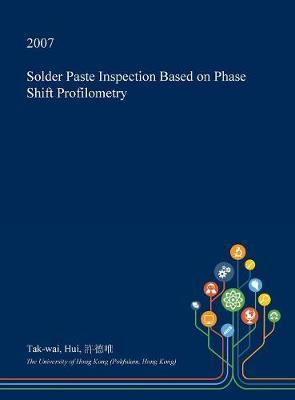Overview
This dissertation, Solder Paste Inspection Based on Phase Shift Profilometry by Tak-wai, Hui, 許德唯, was obtained from The University of Hong Kong (Pokfulam, Hong Kong) and is being sold pursuant to Creative Commons: Attribution 3.0 Hong Kong License. The content of this dissertation has not been altered in any way. We have altered the formatting in order to facilitate the ease of printing and reading of the dissertation. All rights not granted by the above license are retained by the author. Abstract: Abstract of thesis entitled Solder Paste Inspection Based on Phase Shift Profilometry Submitted by HUI Tak Wai for the degree of Master of Philosophy at The University of Hong Kong in August 2007 Manufacturing of printed circuit board (PCB) requires the monitor of each assembly process so as to produce good quality electronic products. PCB assembly manufactures are demanding better yields for their assembly lines by the use of closed-loop process controls. It is estimated that 52 - 71% of surface mount technology (SMT) defects are related to the solder paste printing process. However, solder paste qualification is very difficult because the height of a solder paste block is typically only 6-10 mils (about 150um- 250um). This study contributes to the development of the methodology and hardware for solder paste inspection. It first reviews previous solder paste inspection approaches. A laser pattern generator is used to project sinusoidal fringe pattern onto the solder paste under inspection. The 3D profile of the solder paste is obtained from a sequence of images acquired from a digital camera mounted on top. The profile is then used for defect detection and volume estimation of the solder paste. The proposed 3D profile reconstruction is based on a new two-step phase shift profilometry (2-step PSP) method with pre-filtering and post-filtering. It requires two p -out-of-phase sinusoidal fringe patterns in the profilometry. Ingeneral, it is very difficult to project ideal sinusoidal fringe patterns. The average of the two sinusoidal patterns not only removes background component but also tries to recover the ideal sinusoidal pattern. Pre-filtering is used to filter the pattern before applying Hilbert transform to obtain the in-quadrature component. Post-filtering is applied in the reconstructed object phase to remove wrongly created structures. The proposed method requires two fewer fringe patterns than the 4-step PSP, which has advantages in terms of practical implementation. The inspection system can be made compact and simple. Compared with the Fourier transform profilometry, the 2-step PSP is better able to reconstruct the 3D profile. The percentages of the average volume accuracy for the 150um, 200um and 250um defect-free solder paste blocks are 96.15%, 94.64% and 96.01% respectively. The percentages of the average volume accuracy for the 150um, 200um and 250um defective solder paste blocks are 94.37%, 95.39% and 96.53% respectively. The average root mean square errors for the 150um, 200um and 250um defect-free solder paste blocks are 18.97um, 23.05um and 28.75um respectively. The average root mean square errors for the 150um, 200um and 250um defective solder paste blocks are 21.07um, 31.33um and 34.1um respectively. After the 3D profile reconstruction of solder paste, defect detection is based on the 3D profile. Each solder paste block is segmented into five small regions. The overall solder paste block is inspected through the use of a global classifier. Each region then uses a local classifier to detect for defect. Each classifier is specific for classifying a solder paste block as defective or not in each region of the solder paste block. From the evaluated results, all the defective solder paste blocks can be correctly recognized as defective. (477 words) DOI: 10.5353/th_b3955841 Subjects: Printed circuitsSurface mount technologySolder paste
Full Product Details
Author: Tak-Wai Hui ,
許德唯
Publisher: Open Dissertation Press
Imprint: Open Dissertation Press
Dimensions:
Width: 21.60cm
, Height: 1.10cm
, Length: 27.90cm
Weight: 0.703kg
ISBN: 9781361471289
ISBN 10: 136147128
Publication Date: 27 January 2017
Audience:
General/trade
,
General
Format: Hardback
Publisher's Status: Active
Availability: Temporarily unavailable

The supplier advises that this item is temporarily unavailable. It will be ordered for you and placed on backorder. Once it does come back in stock, we will ship it out to you.



